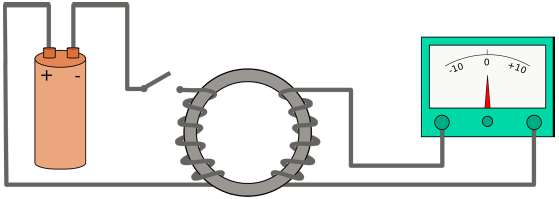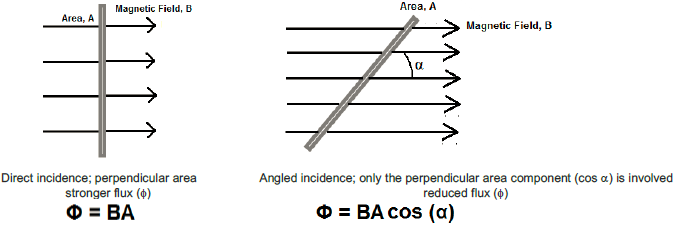Module 8 – Magnetic Induction
INTRODUCTION
Magnetic induction is the creation of an electric current by the change in the magnetic flux, which is determined by the strength of the magnetic field and the perpendicular area upon which it is acting. Some background is in order to understand the above statement. Scientists long ago showed that current in a wire produced a magnetic field around the wire. In short, current can produce magnetic fields. Michael Faraday and other scientists of his time wondered if the opposite were true—could you produce an electric current from a magnetic field? Faraday's experiment was setup with an electromagnet on one side (a power supply attached to a wire coiled around one side of the iron ring) and a wire wrapped around the other side of the iron ring and then connected to a galvanometer.
Figure 1
MAGNETIC FLUX
Magnetic flux is how a material is affected by a magnetic field. An analogy would be how light from the sun affects materials, like you. Whether or not you will get sunburned is determined by the intensity of the sunlight, which in turn is a product of two key factors (other than covering): the amount of incident sunlight and the angle at which it strikes you. A strong beam of sunlight directly on your outstretched arm can create a warm or hot feeling rather quickly. The effect is that you get sunburned more readily when the sun is highest in the sky and shining directly down onto you (greater intensity because the light is striking you at close to a 90° angle—shoulders, top of your head, nose, etc.). However, when that same incident beam of sunlight strikes you at an oblique angle, the area the beam covers is larger, thus reducing the intensity. The effect is that you do not normally get sunburned in the late afternoon. Similarly, the magnetic flux (relating to change) is the product of the strength of the magnetic field and the surface area perpendicular to it. However, unlike the sunlight example, we are looking for a change in the magnetic flux, which can be produced by a change in either one of these two factors. A constant magnetic field on a constant area will not produce a current (as Faraday discovered). Either the magnetic field must change—increase, decrease, or flip polarity—or the surface area of the material perpendicular to the field must change—increase or decrease. Note: Changing the angle of the material changes the angle of incidence of the magnetic field and thus changes the perpendicular surface area.
Figure 2
MAGNETIC INDUCTION
"Magnetic induction is the creation of an electric current by the change in the magnetic flux, which is determined by the strength of the magnetic field and the perpendicular area upon which it is acting." This opening statement should now be more easily understood. When a coil of wires passes through a perpendicular magnetic field, magnetic induction occurs. The change in magnetic flux induces the electric current. Magnetic fields are measured in units of teslas (T), named after Nikola Tesla. Since the tesla unit is quite large most magnets require micro- or milli- prefixes to describe the strength of their magnetic fields. The unit of gauss (G) is also used (1 G = 10–4 T).PROCEDURE
This experiment consists of five parts.1
Open the experiment instructions and worksheet.
-
•Magnetic Induction Experiment Instructions (PDF)
-
•Magnetic Induction Experiment Worksheet
2
After you have thoroughly read the instructions and worksheet, open the experiment simulation in which you will conduct the experiment and collect your data.
3
Record your data in the worksheet. (You will need it for the experiment report assignment in WebAssign.)
